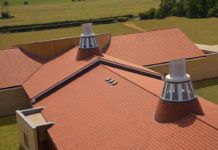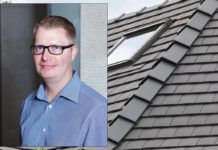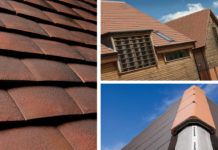One of the areas of a pitched roof most prone to leakage if not constructed properly, is the valley. It is an area where water is directed towards, rather than away from, therefore correct detailing and construction is essential.
A common misconception is that the mortar bedding is there to prevent water access. However, in reality, a valley should work correctly even without mortar. Think of double lap plain tile valleys and slate valleys; these do not use mortar. In Scotland, single lap tile valleys are commonly installed without mortar.
So, how should a valley be constructed? Firstly, it is important to get the structure under the valley right. The valley boards should be set flush with the tops of the rafters rather than simply laid on top of the rafters. That way, the tiling does not need to rise over the edges of the valley. Setting the valley boards flush requires extra work as the boarding must be cut to fit between the rafters, supported on extra timbers fixed to the sides of the rafters. Thin plywood linings are fitted over the valley boards to maintain a smooth finish under a lead-lined valley.
The width of the open valley is dependent upon the roof pitch and the volume of water expected to drain into the gutter. BS 5534: 2014: Table 11 gives the minimum recommended valley widths for different roof pitches and plan areas.
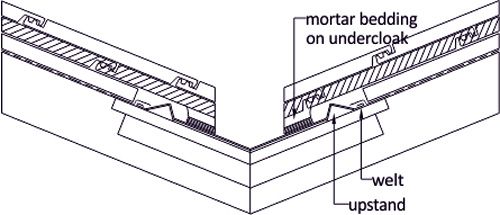
Lead lined valleys
The underlay on each side of the valley should overlap the valley sides, rather than passing under the lead lining. This practice emanated from the use of bituminous underlays, to prevent the lead from sticking to the bitumen in hot weather. This is not usually a problem with modern vapour permeable and other non-bituminous underlays.
The upstands, or tilting fillets, at each side of the valley are an important feature of good valley construction as they keep the water within the centre area of the valley. Nevertheless, they are often omitted from lead valleys. The upstands will prevent water ingress even if the mortar is missing or damaged.
As a final barrier against water ingress, the edges of the lead should be turned over to form a welt. Mortar bedding should never be laid directly onto the lead, as the expansion and contraction of the lead with temperature will quickly crack the mortar. Instead, the mortar should be laid onto an undercloak of slate, tile or fibre-cement board to allow movement between the lead and the undercloak.
To prevent water passing over the upstands, there should be a gap of at least 25mm between the mortar bed and the upstand. Tiles should be cut neatly to form the required open valley width and all cut pieces must be twice fixed, by combination of nailing or screwing at the head and clipping at the tail. Very small cuts pieces can be bonded to the adjacent full tile using a suitable adhesive, so long as that is fully mechanically fixed to the batten. Where available, use tile-and-half tiles to give as large a cut tile as possible.
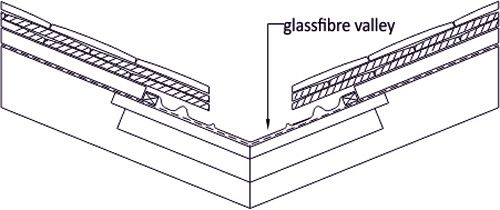
Preformed GRP valleys
In many ways, the roof construction for a pre-formed GRP valley is the same as that for a lead lined valley. Some GRP valleys are sufficiently robust to enable them to be laid directly over the rafters, rather than being supported on valley boards. It is therefore worth asking the valley manufacturer for guidance on this. The underlay can be laid directly under the valley lining as there is no likelihood of the valley sticking to the underlay.
It is good practice to lay a width of underlay along the valley and then overlap the general underlay on each side of the valley over this. GRP valleys have pre-formed upstands to prevent the ingress of water and, for mortar bedding, some have integral sand strips to ensure a good adhesion between the mortar and valley lining.
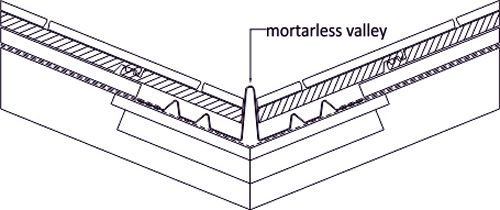
Preformed mortarless valleys
The roof construction for mortarless valleys is similar to that for open GRP valleys. Instead of having an open channel like traditional valleys, mortarless valleys have a central upstand and the tiling is finished close to the upstand on each side. These valleys have large upstands each side of the upstand to direct water towards the gutter without discharging over its edges.
Valleys with central upstands are beneficial where two roof slopes of unequal pitches meet at a valley. With open valleys, there is a risk that water from the steeper roof slope will run across and run over the edges of the valley on the lesser pitch slope. A central upstand will prevent this from happening.
In summary
- It is important to get the roof construction correct at the valleys. For example, install valley boards flush with the rafters, not on top.
- It is the upstands that prevent water from entering the roof space, not the mortar. Make sure they are properly formed.
- Do not lay mortar bedding directly onto a lead valley; use a slip course of slate, tile or fibre cement board.

